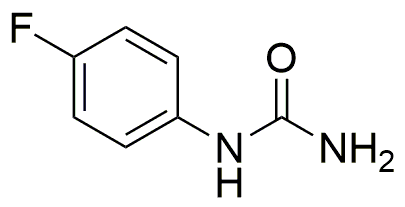(4-Fluorophenyl)urea is widely utilized in research focused on:
- Pharmaceutical Development: This compound serves as a key intermediate in the synthesis of various pharmaceuticals, particularly in the development of anti-cancer agents. Its unique fluorine substitution enhances biological activity and selectivity.
- Agricultural Chemistry: It is employed in the formulation of herbicides and pesticides, providing effective weed control while minimizing environmental impact. The fluorine atom contributes to the stability and efficacy of these agrochemicals.
- Material Science: (4-Fluorophenyl)urea is used in creating polymers and resins, which are essential in manufacturing durable materials. Its properties improve thermal stability and mechanical strength in composite materials.
- Biochemical Research: Researchers utilize this compound in studies related to enzyme inhibition and receptor binding, aiding in the understanding of various biological processes and disease mechanisms.
- Analytical Chemistry: It is applied in the development of analytical methods for detecting and quantifying other compounds, enhancing the accuracy and reliability of chemical analysis in laboratories.
General Information
Properties
Safety and Regulations
Applications
(4-Fluorophenyl)urea is widely utilized in research focused on:
- Pharmaceutical Development: This compound serves as a key intermediate in the synthesis of various pharmaceuticals, particularly in the development of anti-cancer agents. Its unique fluorine substitution enhances biological activity and selectivity.
- Agricultural Chemistry: It is employed in the formulation of herbicides and pesticides, providing effective weed control while minimizing environmental impact. The fluorine atom contributes to the stability and efficacy of these agrochemicals.
- Material Science: (4-Fluorophenyl)urea is used in creating polymers and resins, which are essential in manufacturing durable materials. Its properties improve thermal stability and mechanical strength in composite materials.
- Biochemical Research: Researchers utilize this compound in studies related to enzyme inhibition and receptor binding, aiding in the understanding of various biological processes and disease mechanisms.
- Analytical Chemistry: It is applied in the development of analytical methods for detecting and quantifying other compounds, enhancing the accuracy and reliability of chemical analysis in laboratories.
Documents
Safety Data Sheets (SDS)
The SDS provides comprehensive safety information on handling, storage, and disposal of the product.
Product Specification (PS)
The PS provides a comprehensive breakdown of the product’s properties, including chemical composition, physical state, purity, and storage requirements. It also details acceptable quality ranges and the product's intended applications.
Certificates of Analysis (COA)
Search for Certificates of Analysis (COA) by entering the products Lot Number. Lot and Batch Numbers can be found on a product’s label following the words ‘Lot’ or ‘Batch’.
*Catalog Number
*Lot Number
Certificates Of Origin (COO)
This COO confirms the country where the product was manufactured, and also details the materials and components used in it and whether it is derived from natural, synthetic, or other specific sources. This certificate may be required for customs, trade, and regulatory compliance.
*Catalog Number
*Lot Number
Safety Data Sheets (SDS)
The SDS provides comprehensive safety information on handling, storage, and disposal of the product.
DownloadProduct Specification (PS)
The PS provides a comprehensive breakdown of the product’s properties, including chemical composition, physical state, purity, and storage requirements. It also details acceptable quality ranges and the product's intended applications.
DownloadCertificates of Analysis (COA)
Search for Certificates of Analysis (COA) by entering the products Lot Number. Lot and Batch Numbers can be found on a product’s label following the words ‘Lot’ or ‘Batch’.
*Catalog Number
*Lot Number
Certificates Of Origin (COO)
This COO confirms the country where the product was manufactured, and also details the materials and components used in it and whether it is derived from natural, synthetic, or other specific sources. This certificate may be required for customs, trade, and regulatory compliance.


